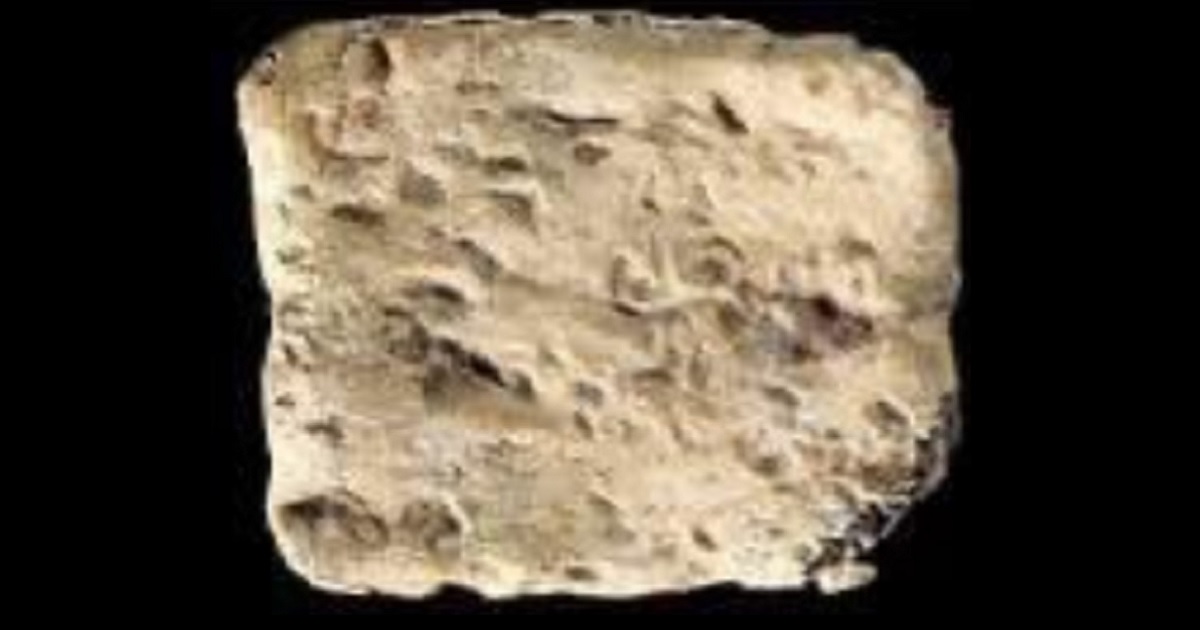On a site in modern-day Israel, academics believe they’ve found the oldest Hebrew text ever discovered, with an apparent link to a scene described in the Old Testament.
A team of scholars affiliated with universities in Israel, the United States, Germany and the Czech Republic are credited with the find, according to The Jerusalem Post.
The findings were published Friday in the academic journal Heritage Science.
The text is described as a “curse tablet” — with an inscription one might expect to find in some of the darker passages of the Old Testament.
“You are cursed by the God YHW,” the text reads — using the sacred Hebrew name for God.
“You will die cursed—cursed you will surely die. Cursed you are by yhw-cursed,” the tablet reads, according to the Jewish News Syndicate.
Scholars date tiny ‘curse tablet,’ found at Mt. Ebal, to 1200 BC – which would prove Israelites were literate when they entered Holy Land.
Archaeologist claims to find oldest Hebrew text in Israel, including the name of Gd.
Read More: https://t.co/qrZZgEOnTr pic.twitter.com/pMFEJvwkEj
— Shirl the Sabra (@sabra_the) May 13, 2023
This tablet from 1400-1200 BCE found in Mount Ebal is the first known use of proto-Hebrew. It says: “You are cursed by the god, yhw, cursed. You will die cursed—cursed you will surely die. Cursed you are by yhw.” Not a very friendly start for the language of the Israelites! pic.twitter.com/2ajbQpaqlv
— The History Of The Land Of Israel Podcast (@TheHistoryOfTh5) May 13, 2023
The tiny lead tablet — only 2 x 2 centimeters square and folded — was first recovered with other materials in a 1980s excavation at Mount Ebal, near the city of Nablus.
However, it remained unnoticed amid discarded material from the excavation until the material was reexamined by a new team in 2019, the Jewish News Syndicate reported.
There was a reason the minuscule tablet was folded, according to the Heritage Science paper — and it’s what made the use of X-ray technology necessary to read it.
“Once a religious functionary inscribed the text and sealed the tablet, the incantation became binding. It could not be erased since the tablet would crumble and the curse would disappear, if opened. Neither humans nor supernatural beings could cancel or negate an occult message since they could not see it. However, this has changed in recent decades as scientists have gained the ability to see the interior of lead tablets using X-ray computed tomography and advanced data processing,” the paper states.
The tablet is at least 200 years older than the previously oldest find in the Hebrew language, according to scholars.
“The text … is the oldest Hebrew text found within the borders of ancient Israel … by at least two centuries,” the authors wrote in Heritage Science.
Mount Ebal is featured in the Old Testament.
The Israelite leader Joshua, who succeeded Moses, is described as building an altar to God at the site in Joshua 8:30 — 35.
“Then Joshua built on Mount Ebal an altar to the Lord, the God of Israel, as Moses the servant of the Lord had commanded the Israelites. He built it according to what is written in the Book of the Law of Moses—an altar of uncut stones, on which no iron tool had been used. On it they offered to the Lord burnt offerings and sacrificed fellowship offerings. There, in the presence of the Israelites, Joshua wrote on stones a copy of the law of Moses. All the Israelites, with their elders, officials and judges, were standing on both sides of the ark of the covenant of the Lord, facing the Levitical priests who carried it. Both the foreigners living among them and the native-born were there. Half of the people stood in front of Mount Gerizim and half of them in front of Mount Ebal, as Moses the servant of the Lord had formerly commanded when he gave instructions to bless the people of Israel.
“Afterward, Joshua read all the words of the law—the blessings and the curses—just as it is written in the Book of the Law. There was not a word of all that Moses had commanded that Joshua did not read to the whole assembly of Israel, including the women and children, and the foreigners who lived among them.”
The 1980s excavations, carried out by University of Haifa professor Adam Zerta, identified two altars constructed in the Bronze Age and the Iron Age.
According to the Heritage Science paper, the “curse tablet” might have been deposited in the Mount Elba altar.
One American academic involved in the finding of the new tablet is emphasizing that Zerta’s excavations uncovered the site in an area featured in the Bible.
“The big point here is that we have evidence of Hebrew writing in Israel earlier than has previously been established, as well as mention of two of names of the Hebrew God, all from the site where the Bible said Joshua built an altar,” Scott Stripling, provost at the Bible Seminary in Katy, Texas, told JNS.
This article appeared originally on The Western Journal.

























 Continue with Google
Continue with Google